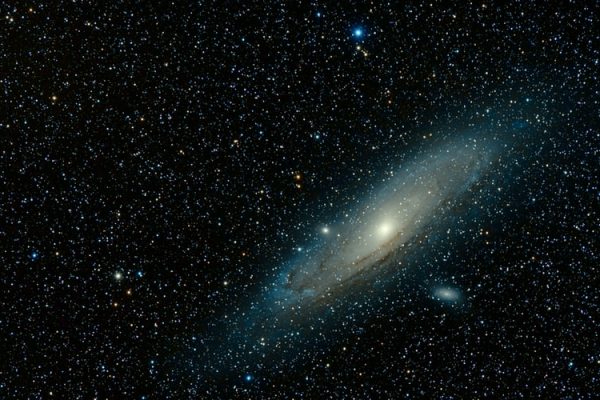The Quran states: “stars and trees all bow in prostration” (55-6), meaning that these acts of prostration are manifestations of the roles they perform in the cosmic order in keeping creation in balance. The forests do this by acting as a total regulatory and supply system for the planet as collectors of water, controllers of climate, preventers of erosion, and hosts to millions of animal and plant species.
The Quran states: “stars and trees all bow in prostration” (55-6), meaning that these acts of prostration are manifestations of the roles they perform in the cosmic order in keeping creation in balance. The forests do this by acting as a total regulatory and supply system for the planet as collectors of water, controllers of climate, preventers of erosion, and hosts to millions of animal and plant species.
This article was written by Fazlun Khalid, the founder and director of the Islamic Foundation for Ecology and Environmental Sciences. You can find the original article on IFEES here.
Islamic law (Shariah) has its roots in the Qur’an and the sayings and actions of Prophet Muhammad known as the Sunnah. The Qur’an asserts that everything belongs to God: “He to whom the kingdom of the heavens and the earth belongs….. He created everything and determined it most exactly” (25-2). The real owner of the natural world is the Creator and He has “showered His blessings upon you both outwardly and inwardly” (31-19). He appointed us as His “Khalifs (stewards) on the earth ……. so He could test you regarding what He has given you (6-167).
This situates us in the arena of a moral relationship with the rest of creation which demands both self-restraint as a control over greed and an awareness of the needs of others which in its best manifestation is generosity. The Sunnah of the Prophet defined these injunctions of the Qur’an as follows:
- The elements that compose the natural world is common property
- The right to benefit from natural resources is a right held in common
- There shall be no damage or infliction of damage bearing in mind future
users
As an extension of this foundational code Muslim legalists have over the centuries established the following principles. A person invalidates his rights over a particular natural resource if by exercising it he:
- Causes detriment to another
- Causes detriment to another without corresponding benefit to the other
- Causes general detriment to society
Additionally:
- Every member of society is entitled to benefit from a common resource to the extent of his need so long as he does not violate, infringe or obstruct the equal rights of other members of society
- Accountability rests with the user
- In return for benefits derived from a renewable resource the user is obliged to maintain its value
- If the user causes destruction, impairment or degradation he is held liable to the extent of putting right the damage caused
It could be said in relation to the forests and the flora and fauna it supports, that we have and are continuing to violate every single one of these principles. The extent of this is such that we have in the past half-century or so cut down vast tracts of virgin forest which as a natural resource not only maintains the ecosystem in balance but by so doing keeps us healthy and alive. The uniqueness of modernity is that it permits us to commit enormous crimes against the protective embrace of the natural world in the name of progress.
It is estimated that ten thousand years ago about 35% of the planet was covered by forest. Surprisingly about 30% of the planet remained under forest cover right up to the middle of the last century. So, all the great civilizations of the past and the industrial revolutions in Europe and North America only consumed roughly 5% of forest cover. Some estimates put this as low as 2%. It is now estimated that only 10% of the surface of the planet has a mantle of intact forest cover left.
We may conclude from these figures that in the last fifty years our present civilization has destroyed more than four times the forest area used by all the other civilizations in the past nine thousand nine hundred and fifty years. History tells us that in the ice age carbon dioxide concentrations in the atmosphere amounted to 200 parts per million (ppm). In the period before the industrial revolution it was estimated to be 270 ppm, in 1850 at 280 ppm and now 350 ppm, rising fast and set to double in the long term, probably in the second half of this century.
We are also told that deforestation adds 2.4 billion tons of carbon dioxide to the atmosphere annually and burning fossil fuels adds another 5.6 billion tons. These figures may be summarised as follows taking into account the fact that a fully grown tree locks anything between 10 to 15 kilograms of carbon dioxide within itself. In the narrow context of the carbon dioxide or the greenhouse gas issue, we are causing a double detriment to ourselves. That is pumping carbon dioxide into the atmosphere at alarmingly increasing rates and destroying the very resource that is able to absorb this.
This may sound like a very complicated and painfully slow way of strangling ourselves to death and if we do not feel the full impact of this in our own lifetimes the next generation almost certainly will. The sensible thing to do would be to reverse one or both, preferably both, of these destructive processes but a politico-economic system that has us dazzled by its consumer culture will not permit us to do it.
Our lifestyles as we have designed it, is now dependent on both producing more carbon dioxide and destroying more forests. To get back to some kind of equilibrium we need to
be planting trees at a feverish rate, not cutting them down. Reforestation schemes lag way behind the rate of destruction and it is also useful to know that it takes anything between twenty to fifty years for a tree to grow to full maturity. The other option is to effect a drastic reduction of the extraction and use of fossil fuels. This will sound like an
unthinkable proposition to many.
Nothing has yet been said of the wider creational frame that trees and forests thrive in. Their diversity, dazzling unity, and coherence not only sustain us but, allow us to live in
an ambiance resembling that of paradise as described in the Qur’an “Give the good news to those who have iman (faith) and do right actions that they will have gardens with
rivers flowing beneath them …” (2- 24).
The Qur’an also says that the “stars and trees all bow in prostration” (55-6), meaning that these acts of prostration are manifestations of the roles they perform in the cosmic order in keeping creation in balance. The forests do this by acting as a total regulatory and supply system for the planet as collectors of water, controllers of climate, preventers of erosion, and hosts to millions of animal and plant species. In addition to locking carbon dioxide, they trigger the chlorophyll effect, they provide us with sustenance, shade, and shelter.
The Prophet (s) said that two trees should be planted for every tree that was cut down and as God’s steward on earth we have not just ignored this advice we have mounted an assault into the very bosom of nature that we shelter in. We have broken the basic codes governing caring, sharing, and conservation. We can of course change our attitude to the natural world by changing the way we perceive it, that is, from a resource to be devoured to a warm mantle that nurtures us. But, we need to hurry or it might be too late.
The Qur’an says:
“It is He who sends down water from the sky. From it you drink and from it come the shrubs among which you graze your herds. And by it He makes crops grow for you and olives and dates and grapes and fruit of every kind. There is certainly a sign in that for people who reflect.” (16-10,11)
References
1. The references from the Qur’an were obtained from the Noble Qur’an (a translation into modern English) by Abdaqlhaqq and Aisha Bewley, Bookwork, Norwich, England, 1999.
2. Othman Abd-ar-Rahman Llewellyn, Conservation in Islamic Law, Paper delivered at the IVth World Congress on National Parks and Protected Areas, Caracas, Venezuela, February 1992.
3. Fazlun M. Khalid, Joanne O’Brien (Eds), Islam and Ecology, Cassell, London, 1992, 2nd edition 1997.
4. Fazlun M. Khalid, Qur’an, Creation and Conservation, Islamic Foundation for Ecology and Environmental Sciences, Birmingham, England, 1999.
5. Norman Myers (ed), The Gia Atlas of Planet Management, Good Books, London, 1985.
6. Jonathan Porritt (ed), Save the Earth, Dorling Kindersely, London, 1991.
7. Andre Singer (ed), Battle for the Planet, Pan Books, London, 1987.





